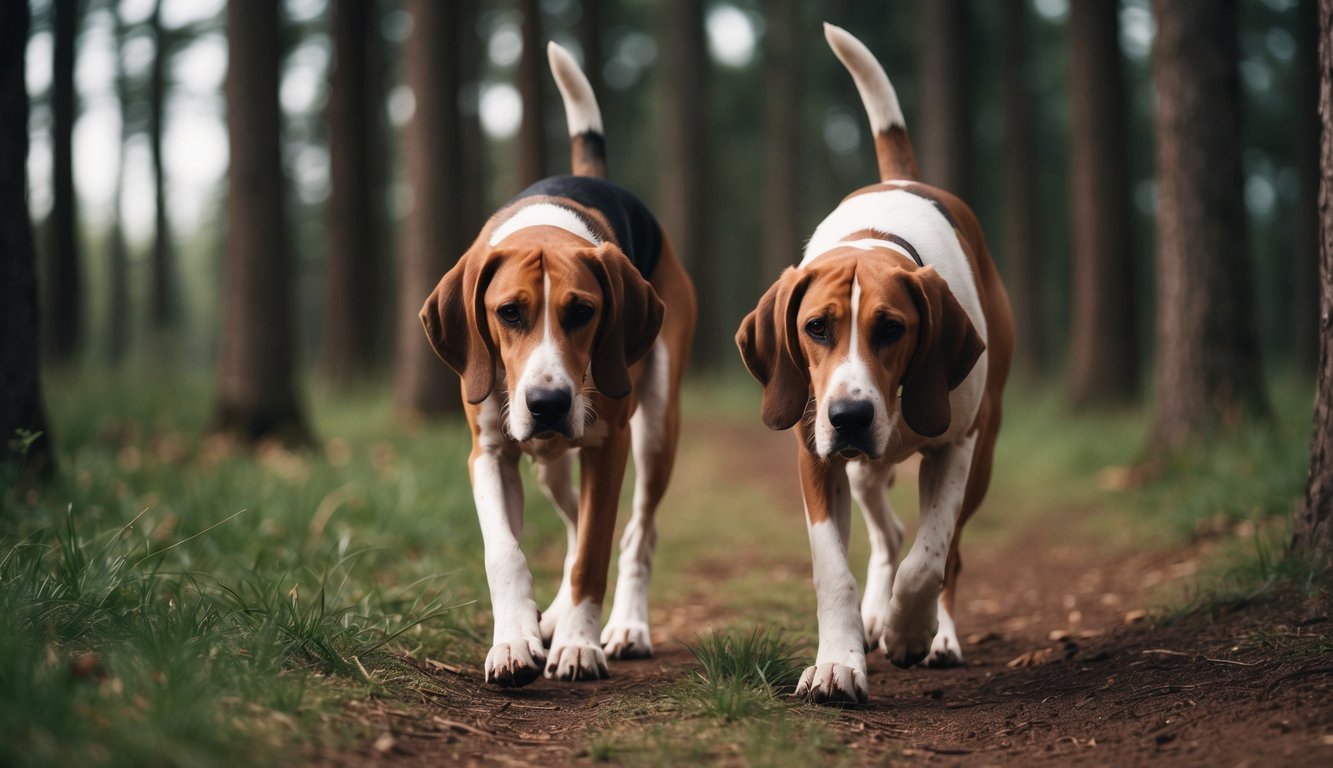Redbone Coonhounds and Bloodhounds are both renowned scent hounds with distinct backgrounds. These breeds have unique origins and lineages that contribute to their exceptional tracking abilities. Let’s take a look at the similarities and differences between these two dog breeds.
If you’re still on the market to buy a Redbone Coonhound or Bloodhound, PuppySpot currently offers a $300 discount using the code PUPPY300, just click the banner below!
Physical Characteristics
Redbone Coonhounds and Bloodhounds have distinct physical traits that set them apart. Their size, weight, and appearance differ in several key ways.
Comparative Size and Weight
- Bloodhounds are generally larger than Redbone Coonhounds. Bloodhounds typically weigh between 80-110 pounds, while Redbone Coonhounds usually weigh 45-70 pounds.
- Bloodhounds stand 23-27 inches tall at the shoulder. Redbone Coonhounds are slightly shorter, measuring 21-27 inches in height.
- The size difference impacts their tracking abilities. Bloodhounds have more stamina for long searches. Redbone Coonhounds are more agile in dense forests.
Coat and Appearance
- Bloodhounds have loose, wrinkled skin and a short, dense coat. Their coat colors include black and tan, liver and tan, or red.
- Redbone Coonhounds have a sleek, smooth coat that is solid red in color. Their coat is shorter and less wrinkled than a Bloodhound’s.
- Both breeds have long, floppy ears. However, a Bloodhound’s ears are longer and more pronounced.
Distinct Physical Traits
- Bloodhounds are known for their droopy faces and excess skin. This loose skin helps trap scents, enhancing their tracking abilities.
- Redbone Coonhounds have a more streamlined appearance with less wrinkled skin. Their eyes are often described as having a pleading expression.
- Bloodhounds tend to drool more due to their loose jowls. This can lead to more frequent ear infections. Redbone Coonhounds drool less and have fewer skin-related health issues.
- Both breeds have strong, muscular bodies built for endurance. Their powerful legs and sturdy frames allow them to track for long periods.

Temperament and Personality
Bloodhounds and Redbone Coonhounds have distinct personalities that shape their behavior as pets and working dogs. These breeds display unique traits in their social interactions and family dynamics.
Behavioral Tendencies
- Bloodhounds are known for their gentle and patient nature. They can be stubborn at times, especially when following a scent. These dogs have a strong prey drive and may become fixated on tracking.
- Redbone Coonhounds are energetic and playful. They need regular exercise and mental stimulation. Their hunting instincts can make them prone to chasing small animals.
- Both breeds can be vocal. Bloodhounds are known for their distinctive howl, while Redbone Coonhounds have a melodious bay. Early training is key to manage barking tendencies.
Affinity Towards Families
- Bloodhounds form strong bonds with their families. They are gentle giants who love cuddles and attention. These dogs can be good with children but may accidentally knock over small kids due to their size.
- Redbone Coonhounds are affectionate and devoted to their owners. They thrive on human companionship and can become anxious if left alone for long periods. These dogs are usually good with kids and other pets when properly socialized.
- Both breeds can be wary of strangers initially. Bloodhounds are generally more laid-back, while Redbone Coonhounds may be more alert and protective of their territory.
Training and Intelligence
Redbone Coonhounds and Bloodhounds are both intelligent breeds with strong tracking abilities. Their training needs and mental stimulation requirements differ slightly.
Trainability and Teaching Methods
- Redbone Coonhounds are eager to please and respond well to positive reinforcement. They learn quickly but can be stubborn at times. Consistency is key in their training.
- Bloodhounds, while intelligent, can be more challenging to train. They have a strong will and may become distracted by scents. Patience and persistence are essential when working with this breed.
- Both dogs benefit from early socialization and obedience training. Short, engaging sessions work best for these scent-driven breeds.
Mental Stimulation Needs
- Redbone Coonhounds require regular mental exercise to stay happy and well-behaved. Puzzle toys, scent games, and tracking activities can help keep their minds sharp.
- Bloodhounds have an exceptional sense of smell and need opportunities to use this ability. Scent trails and search exercises are ideal for keeping them mentally stimulated.
- Both breeds enjoy outdoor activities that allow them to use their noses. Regular exercise and mental challenges help prevent boredom and destructive behaviors.
Exercise and Activity Level
Redbone Coonhounds and Bloodhounds have different exercise needs and energy levels. Their ideal living environments also vary based on their activity requirements.
Ideal Living Environment
Redbone Coonhounds thrive in homes with large, fenced yards. They need space to run and explore. These dogs are best suited for the countryside or suburbs rather than city apartments. Bloodhounds can adapt to various living situations. They do well in homes with yards but can also live in apartments if given enough exercise. Their lower energy level makes them more flexible in terms of living environment.
Exercise Needs and Adaptability
Redbone Coonhounds have high exercise requirements. They need daily vigorous activity to stay happy and healthy. This breed enjoys:
- Long walks or jogs
- Hiking trails
- Swimming
- Fetch games
Bloodhounds have medium exercise needs. They benefit from:
- Daily walks
- Playtime in a fenced yard
- Scent-based activities
Both breeds have a strong wanderlust potential. Secure fencing is crucial to prevent them from following interesting scents. Redbone Coonhounds are more energetic and less adaptable to apartment living compared to Bloodhounds.

Health and Lifespan
Redbone Coonhounds and Bloodhounds are both sturdy breeds, but they face different health challenges. Their lifespans and common health issues vary, impacting their quality of life and care needs.
Common Health Concerns
- Redbone Coonhounds typically live 12 to 15 years. They are generally healthy dogs but can face some breed-specific issues.
- Hip dysplasia is a concern for Redbone Coonhounds. This condition affects the hip joint and can lead to pain and mobility issues.
- Bloodhounds have a shorter lifespan of 11 to 15 years. They are prone to several health problems due to their unique physical features.
- Bloat is a serious risk for Bloodhounds. This life-threatening condition causes the stomach to fill with gas and potentially twist.
- Entropion, where the eyelid rolls inward, is another issue Bloodhounds face. It can cause eye irritation and requires surgical correction.
Health Management and Prevention
- Regular vet check-ups are crucial for both breeds. These visits help catch potential health issues early.
- For Redbone Coonhounds, maintaining a healthy weight is key. It reduces strain on their joints and helps prevent hip dysplasia.
- Bloodhound owners should be vigilant about bloat symptoms. Feeding smaller, more frequent meals can help reduce the risk.
- Eye care is important for Bloodhounds. Regular cleaning of their facial folds prevents skin infections.
- Both breeds benefit from regular exercise. It keeps them mentally stimulated and physically fit, reducing the risk of obesity-related health problems.
- Proper dental care is essential for both breeds. Regular teeth brushing helps prevent gum disease and other oral health issues.

Grooming Needs and Maintenance
Redbone Coonhounds and Bloodhounds have different coat types that affect their grooming needs. Both breeds shed and drool, but the amount varies. Regular grooming helps maintain their scenting abilities.
Grooming Routines
- Redbone Coonhounds have short, smooth coats that are easy to care for. They need weekly brushing to remove loose hair and dirt. Bathing is only necessary every few months or when they get dirty.
- Bloodhounds have loose, wrinkled skin and a short dense coat. They require more frequent bathing, about once a month, to prevent skin infections in their folds. Daily wiping of their facial wrinkles is important to remove drool and debris.
- Both breeds need regular nail trims, ear cleaning, and teeth brushing. Bloodhounds may need more attention to their ears due to their long, droopy shape.
Managing Shedding
- Redbone Coonhounds and Bloodhounds are moderate shedders. Regular brushing helps control shedding for both breeds.
- Redbone Coonhounds shed seasonally, with heavier shedding in spring and fall. Using a rubber curry brush or grooming mitt can help remove loose hair effectively.
- Bloodhounds shed year-round due to their denser coat. They may benefit from more frequent brushing, up to 2-3 times a week, to manage shedding. A de-shedding tool can be useful during heavy shedding periods.
- Both breeds may drool, but Bloodhounds are known for excessive drooling. Keeping a cloth handy to wipe their jowls can help manage this issue.





